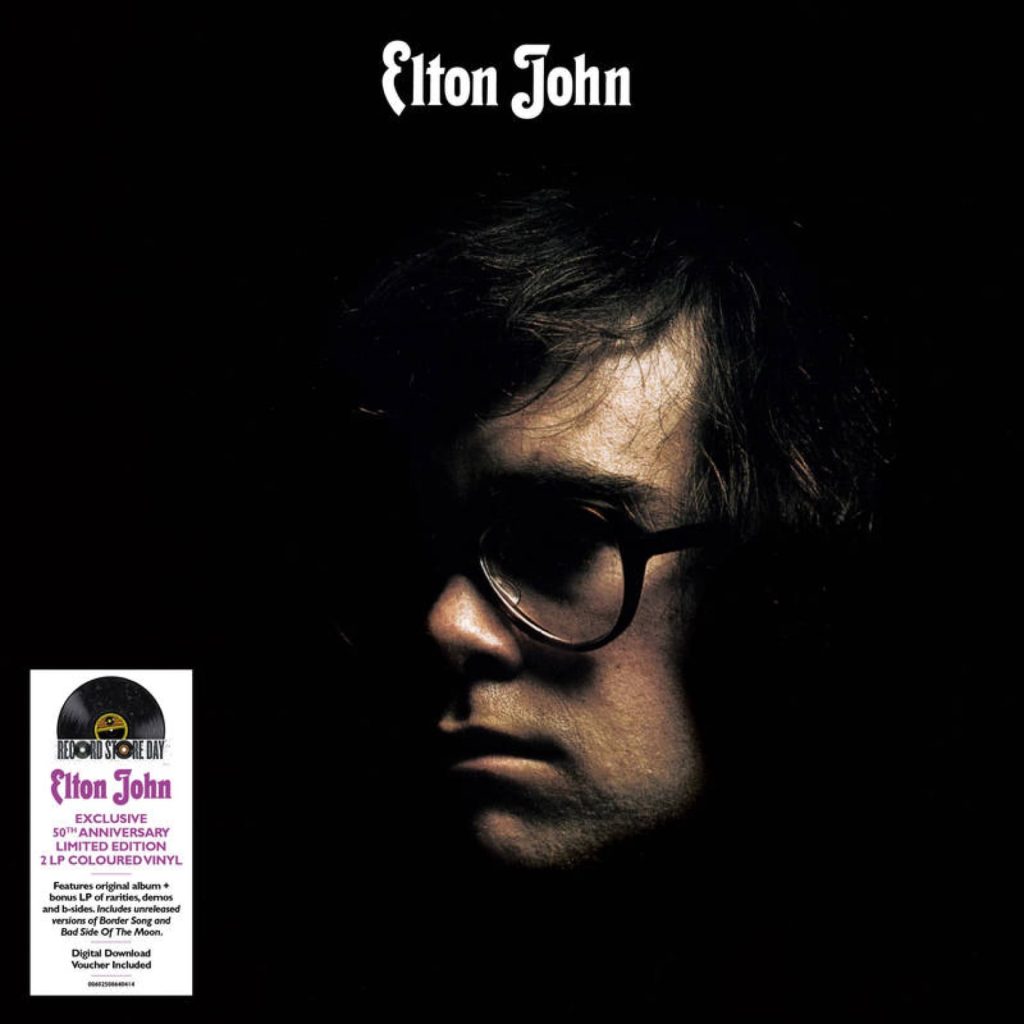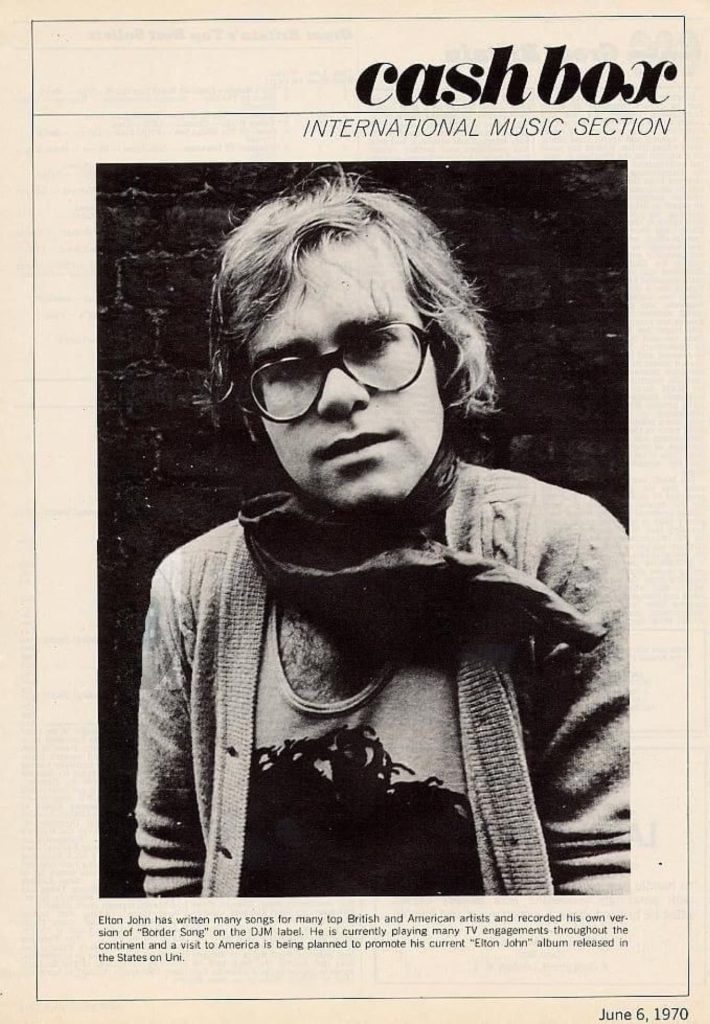Menu
50 Years On: Remembering the ‘Elton John’ Album, Part 3
To mark the 50th anniversary of Elton’s self-titled second album, we’re looking back on the record that made Elton a star.
This article is the third instalment of a three-part series. If you haven’t read Part One yet, which looks at the background and leadup to the recording of the album, you can do so here. Part Two looks at the recording session.
In Part Three, we take a look at the 1970 release of the Elton John album, as well as the bonus tracks found on the Record Store Day double LP released on August 29.
By John F. Higgins

Following the four days of recording the songs, and another day of backing vocals and remaining little bits, it came time to mix the album, which took just the following week. When the work was completed, the only thing left to do was take a breath and reflect on what had just happened.
Gus Dudgeon (producer): “We just never stopped smirking. We smirked 24 hours a day. We just kept going, ‘This is amazing!’ None of us had quite realized how amazing the whole thing was until it actually came out the speakers. The idea of taking a rhythm section and an orchestra and doing them live at the same time, with the kind of classical overtones within Elton’s piano playing and the way Paul Buckmaster wrote his arrangements on that album, added up to something completely unique. The big thrill, which is silly really, was when you walked up Carnaby Street [a popular shopping area near Trident Studios] you heard that album coming out of every single boutique. It was either that or [The Who’s] Tommy. So, not only was it a very special part of Elton’s career, it was a very special part of my career as well.”
David Larkham (album designer): “Steve Brown and I realized that this was a more serious-minded album [than Empty Sky], lyric-wise and music-wise. To me, it was very moody, and I suggested to Steve something along the lines of a Rembrandt portrait. So, I told the photographer, Roger Stowell, ‘Do different portraits, but at least get one that is a very moody close-up.’ The rear cover photo, of the seven people, is in fact two photos stitched together. Stowell realized he would lose some detail if he tried to get them all in one shot, so there was one shot with three people in it, and another one with four. And we all loved the Crosby, Stills & Nash album that had just come out, Déjà Vu. The US import had that grainy texture on the cover that was so great, so we took that idea and used it for the Elton John album cover.”
Ray Williams (manager): “I was just so excited to see this album come together; I was even more excited when it came out. I think everybody did great work…we worked our asses off on it. I felt there was a lot of pressure to do a lot of things in a short space of time, but everybody managed it. If you look at that year, 1970, it’s quite amazing! Recording three albums, two trips to America and to Europe, the Roundhouse – which really was the first gig that the trio did. I remember he knocked over the piano stool by accident there, and the crowd went crazy, so he did it again!
“In those days, the most important thing was to make sure that the local newspapers, and national newspapers and music magazines line Melody Maker and NME, were getting the word out. Reviews were very important. Radio shows. Interviews, etc. Great Britain is a small country. They had a captive audience then, not like it is now with so many things going on. People would watch Top Of The Pops and Ready! Steady! Go! every week religiously. So, Dick’s publicist, Helen Walters, and everybody would be trying to get things. I think we must have pulled every relationship going. It eventually clicked, but it took time and lots of different ideas.
“When I look back, I find it funny how much of a job it was to convince people that this was a great album and that the two were a great songwriting team. It’s so evident, isn’t it? But back then, trying to get a play on BBC, or whatever. Bloody hell! But we got incredible reviews (I put together a laminated page of some of the top ones) and a few TV shows in different parts of Europe.”
Elton performed Border Song on Top Of The Pops on April 2, 1970, as well as in Hamburg, Berlin, and Stockholm during the summer. Overall, he played more than 80 gigs in the UK and Europe before heading over to the United States in August.
ALBUM AND SINGLE RELEASE INFO:
UK
Album:
Elton John (DJM DJLPS 406) was released on April 10, 1970. The album entered the UK Album Chart on May 23 at #48 and fell out after two weeks. It re-entered on the strength of the Your Song single on February 6, 1971 and stayed on for 13 weeks, peaking at #5 on March 13. With other brief re-appearances on the chart throughout the first half of 1971, the LP ended up spending a total of 22 weeks on the UKAC Top 100, 17 of them in the Top 10.
Singles:
Border Song (DJS 217) was issued on March 20, 1970, the same day that Elton began recording songs for his next album, Tumbleweed Connection. Backed with Bad Side Of The Moon, the single did not chart.
Your Song was released as the second single in January 1971, more than two months after it came out in the US. In both countries, the b-side had a mono version of Take Me To The Pilot, with an alternate sequence to the album of fade-out vocal ad libs. The single peaked at #30 on the UK Official Singles Chart in its second week of a 12-week run in early 1971. It has returned to the UK charts a number of times since, with an overall peak position of #4 in July 2002.

US
Album:
Elton John (UNI 73090) was released on July 22, 1970. Slowly supported by Elton’s live concerts from August onwards, the album entered the Billboard Top 200 charts at #156 on October 3, staying on the chart for 51 weeks and peaking at #4 on February 6, 1971.
Singles:
Border Song was originally released on the Congress label and was re-issued in July 1970 on UNI (55246). (It became Elton’s first charting release anywhere in the world when it entered Canada’s RPM100 Singles chart at #96 on August 8, 1970.) When it entered the Billboard Hot 100 Singles chart on August 15 at #93, Border Song became Elton’s first charting product in the US. It stayed on that chart for five weeks, peaking at #92.
Your Song came out in the US on October 26, 1970, peaking at #8 (where it stayed for 4 weeks) on the Billboard chart on January 23, 1971. On February 4, it peaked at #9 on the Billboard Adult Contemporary chart – starting a run of 72 appearances to date on that chart, the most of any artist in the chart’s history.
Elton and the album garnered 3 nominations at the 13th Annual GRAMMY Awards: Album of the Year, Best New Artist of the Year, and Best Contemporary Vocal Performance – Male.
RECORD STORE DAY BONUS LP
Piano Demos
All recorded in 1969 at Dick James Studios, 71-75 New Oxford Street, London, UK.
Your Song (Piano Demo): 1st release on vinyl.
I Need You To Turn To (Piano Demo): 1st release on vinyl.
Take Me To The Pilot (Piano Demo): 1st release on vinyl.
Sixty Years On (Piano Demo): 1st release on vinyl.
Border Song (Piano Demo): From the private collection of Peter Thomas, 1st release on any format.
Bad Side Of The Moon (Piano Demo): From the Universal archives, 1st release on any format.
Thank You Mama (Piano Demo): Considered for the Elton John sessions but never recorded – 1st release on vinyl.
All The Way Down To El Paso (Piano Demo): Considered for the sessions but never recorded – 1st release on vinyl.
I’m Going Home (Piano Demo): Considered for the sessions but never recorded – 1st release on vinyl.
Bad Side Of The Moon
Recorded at Trident Studios: January 21, 1970 (9-11 pm session). The first Elton song arranged by Paul Buckmaster.
Originally released as the B-side to Border Song.
Musicians
Elton: vocals / Caleb Quaye: electric lead guitar / Barry Morgan: drums / Alan Weighill: bass guitar / Dennis Lopez or Tex Navarra: percussion (congas). Overdubs: Madeline Bell, Tony Burrows, Roger Cook, Lesley Duncan, Kay Garner, Tony Hazzard: backing vocals / orchestra.
Grey Seal
Recorded at Trident Studios: January 22, 1970 (9-11 pm session).
Electric piano intro recorded separately during same session.
Originally released as the B-side to Rock And Roll Madonna.
Musicians
Elton: electric piano, piano and vocals / Caleb Quaye: guitar / Les Thatcher: guitar / Terry Cox: drums / Herbie Flowers: bass guitar / Ray Cooper or other?: vibraphone – uncredited. Overdubs: Diana Lewis: Moog Modular synthesizer / orchestra.
Rock And Roll Madonna
Recorded at Trident Studios: March 20, 1970. Take 4.
Audience noise and horns added on later, possibly at Dick James Studios.
Originally released as a single in the UK only on June 19, 1970. It did not chart. It also was swapped in for I Need You To Turn To on the German issue of the Elton John album, on the Hansa label, as the first song.
Musicians
Elton: piano and vocals / Caleb Quaye: electric guitar / Roger Pope: drums / David Glover: bass guitar. Overdubs: horns / audience noise (taken from The Jimi Hendrix Experience live at the Royal Albert Hall).
Interview with Gus Dudgeon: 1993
Interviews with David Larkham and Ray Williams: March 2020
